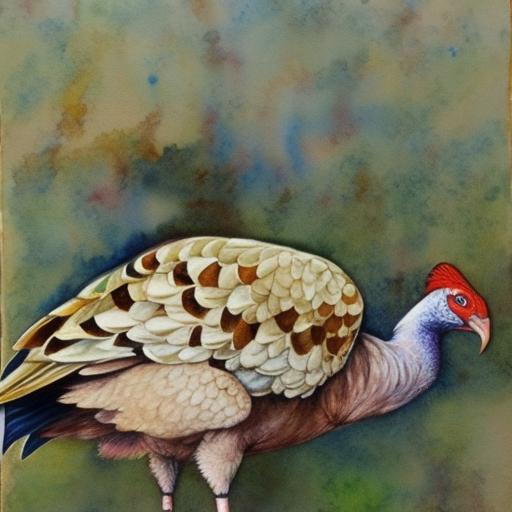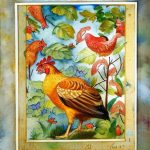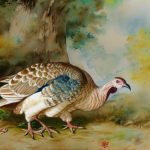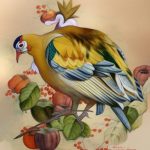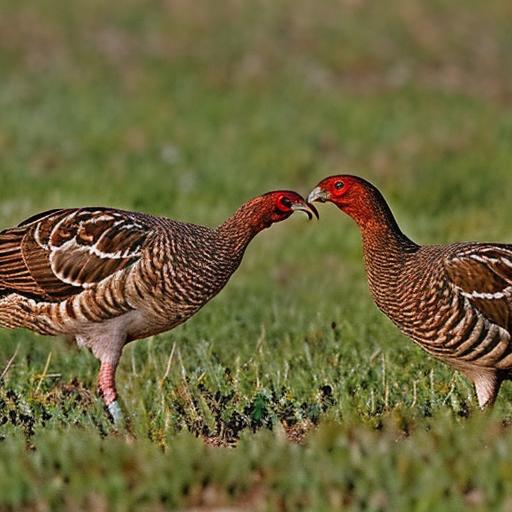Turkeys are a popular poultry species that are raised for their meat and feathers. There are several different breeds of turkeys, each with its own unique characteristics and traits. Some of the most common turkey breeds include the Broad Breasted White, Broad Breasted Bronze, Bourbon Red, Narragansett, and Royal Palm. Each breed has its own distinct coloration, size, and growth rate, making them suitable for different purposes.
The Broad Breasted White and Broad Breasted Bronze are the most commonly raised breeds for meat production due to their large size and fast growth rate. The Bourbon Red is known for its excellent flavor and is often raised for its high-quality meat. The Narragansett and Royal Palm breeds are smaller in size and are often raised for their attractive plumage and as exhibition birds. Understanding the characteristics of each breed is important for turkey farmers to make informed decisions about which breed to raise based on their specific needs and goals.
Turkeys have been domesticated for thousands of years, and selective breeding has led to the development of various breeds with specific traits. Whether raised for meat production, exhibition, or as pets, turkeys come in a wide range of sizes, colors, and temperaments. It is important for turkey farmers to understand the different breeds and their unique characteristics in order to make informed decisions about breeding, raising, and managing their flocks.
Key Takeaways
- There are several breeds of turkeys, each with unique characteristics and traits.
- Turkey mating behavior is influenced by factors such as age, size, and social hierarchy within the flock.
- Factors affecting turkey mating include lighting, nutrition, and flock management practices.
- Crossbreeding can result in hybrid turkeys with desirable traits such as increased size and disease resistance.
- Challenges in crossbreeding include maintaining genetic diversity and managing potential health issues in hybrid turkeys.
Reproduction and Mating Behavior in Turkeys
Reproduction in turkeys is a complex process that involves specific mating behaviors and environmental factors. Male turkeys, known as toms, display elaborate courtship behaviors to attract females, known as hens. During the breeding season, toms will puff out their feathers, fan their tails, strut, and make vocalizations to attract hens. This behavior is known as strutting, and it is a crucial part of the mating process in turkeys.
Once a tom has attracted a hen, he will perform a courtship display by circling her while puffing out his feathers and making soft clucking sounds. If the hen is receptive, she will crouch down and allow the tom to mount her for copulation. After mating, the hen will lay a clutch of eggs over a period of several days before she begins incubating them. Understanding the mating behavior of turkeys is important for turkey farmers to ensure successful reproduction and egg production within their flocks.
Mating behavior in turkeys is influenced by various factors such as age, genetics, and environmental conditions. Toms reach sexual maturity at around 8-10 months of age, while hens typically begin laying eggs at 7-8 months of age. It is important for turkey farmers to consider the age of their birds when planning for breeding and reproduction. Additionally, genetics play a significant role in mating behavior, as certain breeds may exhibit different courtship displays and mating preferences. Environmental factors such as lighting, temperature, and housing conditions can also impact turkey mating behavior and reproductive success.
Factors Affecting Turkey Mating
Several factors can affect turkey mating behavior and reproductive success, including nutrition, lighting, housing conditions, and flock management practices. Proper nutrition is essential for maintaining reproductive health in turkeys. A well-balanced diet that meets the specific nutritional requirements of breeding turkeys is crucial for optimal egg production and fertility. Nutritional deficiencies can lead to poor egg quality, reduced hatchability, and decreased reproductive performance in turkey flocks.
Lighting plays a critical role in regulating turkey reproductive behavior. The length of daylight hours can influence the onset of sexual maturity, egg production, and mating behavior in turkeys. Providing the appropriate lighting conditions through natural or artificial light can help stimulate reproductive activity in turkey flocks. Housing conditions also play a significant role in turkey mating behavior. Providing adequate space, nesting areas, and environmental enrichment can create a conducive environment for successful mating and reproduction.
Flock management practices such as flock size, male-to-female ratio, and social dynamics can impact turkey mating behavior. Overcrowding or imbalanced sex ratios within a flock can lead to increased competition for mates and aggression among birds, which can negatively affect mating behavior and reproductive success. It is important for turkey farmers to implement proper flock management practices to create a harmonious environment that supports natural mating behaviors and reproductive performance in their flocks.
Crossbreeding and Hybrid Turkeys
Crossbreeding is the practice of mating individuals from different breeds or genetic lines to produce offspring with desirable traits from both parent breeds. In the turkey industry, crossbreeding is commonly used to improve traits such as growth rate, feed efficiency, disease resistance, and meat quality. By carefully selecting parent breeds with complementary traits, turkey breeders can produce hybrid offspring that exhibit superior performance and productivity compared to purebred turkeys.
One common example of crossbreeding in turkeys is the production of commercial hybrid strains such as the Hybrid Converter and Hybrid Standard. These hybrids are created by crossing specific purebred lines to achieve optimal growth rates, feed conversion ratios, and meat quality characteristics. Commercial hybrid turkeys are widely used in the meat production industry due to their superior performance and efficiency compared to purebred turkeys.
Crossbreeding can also be used to introduce new genetic traits or improve existing traits within turkey populations. By incorporating genetic diversity from different breeds or lines, turkey breeders can enhance traits such as disease resistance, adaptability to environmental conditions, and reproductive performance. Crossbreeding offers a valuable tool for genetic improvement in turkey populations and can help address specific challenges or limitations associated with purebred lines.
Challenges and Considerations in Crossbreeding
While crossbreeding offers numerous benefits for genetic improvement in turkey populations, there are also challenges and considerations that must be taken into account. One challenge of crossbreeding is maintaining genetic purity within purebred lines while simultaneously producing hybrid offspring. Careful management of breeding programs and genetic selection is essential to prevent genetic dilution or loss of valuable traits within purebred turkey populations.
Another consideration in crossbreeding is the potential for heterosis or hybrid vigor in offspring. Heterosis refers to the phenomenon where hybrid offspring exhibit superior performance or fitness compared to their purebred parents. While heterosis can be advantageous in terms of growth rate, disease resistance, and reproductive performance, it is important for turkey breeders to carefully manage hybrid populations to maintain consistent performance across generations.
Additionally, crossbreeding requires careful planning and selection of parent breeds to ensure compatibility and complementarity of traits. Understanding the genetic background and performance characteristics of different breeds is crucial for successful crossbreeding programs. Turkey breeders must also consider the long-term implications of crossbreeding on population genetics, trait expression, and overall performance within their flocks.
Genetic Implications of Crossbreeding

Crossbreeding can have significant genetic implications for turkey populations, including changes in allele frequencies, trait expression, and genetic diversity. Introducing new genetic material through crossbreeding can lead to shifts in allele frequencies within populations, which may impact the expression of specific traits or phenotypes. Careful monitoring of genetic changes through pedigree analysis and molecular genetics is essential for understanding the genetic implications of crossbreeding in turkey populations.
Crossbreeding can also influence genetic diversity within turkey populations by introducing new alleles or gene combinations from different breeds or lines. Maintaining genetic diversity is important for preserving adaptive potential and resilience to environmental challenges within turkey populations. By incorporating genetic diversity through crossbreeding, turkey breeders can enhance overall population fitness and adaptability.
Furthermore, crossbreeding can lead to the development of new genetic combinations that may exhibit novel phenotypic traits or performance characteristics. By selecting for specific traits in hybrid offspring, turkey breeders can create new genetic combinations that offer unique advantages in terms of growth rate, feed efficiency, disease resistance, or other desirable traits. Understanding the genetic implications of crossbreeding is essential for making informed breeding decisions and managing genetic diversity within turkey populations.
Conclusion and Future Considerations
In conclusion, understanding the different breeds of turkeys and their unique characteristics is essential for making informed decisions about breeding, raising, and managing turkey flocks. Reproduction and mating behavior in turkeys are influenced by various factors such as age, genetics, nutrition, lighting, housing conditions, and flock management practices. Crossbreeding offers valuable opportunities for genetic improvement in turkey populations by producing hybrid offspring with desirable traits from different parent breeds.
Challenges and considerations in crossbreeding include maintaining genetic purity within purebred lines, managing heterosis in hybrid populations, and carefully selecting parent breeds for compatibility and complementarity of traits. Genetic implications of crossbreeding include changes in allele frequencies, genetic diversity, trait expression, and the development of new genetic combinations with unique phenotypic traits. Moving forward, future considerations for turkey breeding should focus on sustainable genetic improvement, maintaining genetic diversity, and addressing specific challenges or limitations within turkey populations through strategic crossbreeding programs. By understanding the complexities of turkey breeding and genetics, turkey farmers and breeders can work towards enhancing the overall performance and productivity of turkey populations while preserving valuable genetic resources for future generations.
If you’re interested in learning more about turkey breeding, you might also find our article on “Understanding Turkey Mating Behavior” helpful. This article explores the different breeds of turkeys and their mating habits, providing valuable insights for poultry enthusiasts. For more information, check out the article here.
FAQs
Can different breeds of turkeys mate?
Yes, different breeds of turkeys can mate with each other. However, there may be some challenges in terms of compatibility and successful breeding.
What are some challenges in mating different breeds of turkeys?
One challenge in mating different breeds of turkeys is that they may have different sizes and body shapes, which can make successful mating more difficult. Additionally, there may be genetic differences that can affect fertility and the health of the offspring.
Are there any specific considerations when breeding different turkey breeds?
When breeding different turkey breeds, it’s important to consider the potential impact on the offspring. Breeders should be aware of any potential genetic issues that could arise and take steps to ensure the health and well-being of the resulting offspring.
Can hybrid turkeys be produced from different breeds?
Yes, hybrid turkeys can be produced from different breeds. Breeders may intentionally cross different breeds to create hybrids with specific traits, such as improved disease resistance or meat quality.
What are some common hybrid turkey breeds?
Common hybrid turkey breeds include the Broad Breasted White, Broad Breasted Bronze, and Beltsville Small White. These hybrids are often bred for their meat production and are commonly used in commercial turkey farming.
Meet Walter, the feathered-friend fanatic of Florida! Nestled in the sunshine state, Walter struts through life with his feathered companions, clucking his way to happiness. With a coop that’s fancier than a five-star hotel, he’s the Don Juan of the chicken world. When he’s not teaching his hens to do the cha-cha, you’ll find him in a heated debate with his prized rooster, Sir Clucks-a-Lot. Walter’s poultry passion is no yolk; he’s the sunny-side-up guy you never knew you needed in your flock of friends!

